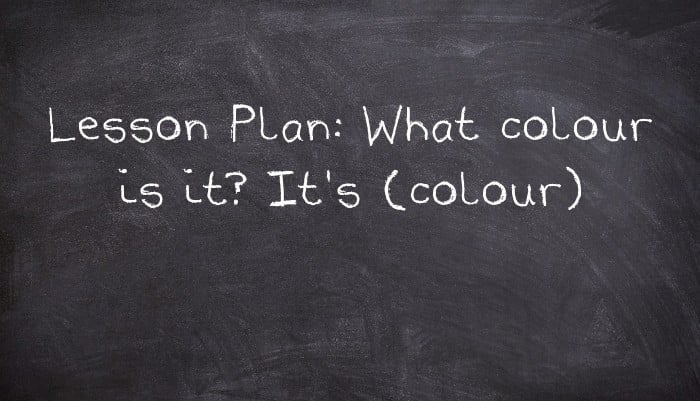Target Language: What colour is it? It's (colour).
Vocabulary: red, green, blue, yellow (flashcards)
Target: Young Learners
Greetings and Warm-up
Greet the class with a good-morning or good-afternoon depending on the day. Have the class stand up and respond to your greeting and do the warm-up. Ask the students, "Do you want to sing a song?". Usually, they'll nod and begin to twitch and move their bodies. Some will respond with a yes. Songs I teach young learners include the "Eensy Weensy Spider", "Head & Shoulders, Knees & Toes", "The Alphabet Song", "Twinkle, Twinkle, Little Star", "Here We Go Round The Mulberry Bush", "Ring Around The Rosey", and "Row, Row, Row Your Boat".
After the warm-up, sit the students down. Introduce the new vocabulary using flashcards. Show the flashcard or place them on the blackboard. Point to the flashcard and say red. Have the students repeat after you. Do this a few times for all the new vocabulary.
Model the dialogue with a puppet. I use a Panda puppet to help me do this. Place the flashcards on the blackboard. Take Panda out of a special bag. Say "Hello Panda" and then introduce him to the class. Ask Panda "What colour is it?" while pointing to the flashcard with the red colour. Panda's answers: "It's red." Do this for all the flashcards and repeat the question/answer routine a couple of times. Make a mistake or two along the way. Point to the green flashcard. Have Panda say, "It's blue." then turn to the students, and have them tell Panda the correct answer.
Divide the class into 2 groups. One group asks the question "What colour is it?" And the other group answers, "It's (colour) depending on the flashcard shown. Run between the two groups. Better still, if you have a helper or if the homeroom teacher is present, ask them to help you. Alternate the dialogue between the two groups a few times until they get the hang of the dialogue.
Activity
Sit the students in a circle. Hold up a flashcard (red), point to it and say, "It's red." Then hold up a ball and say, "What colour is it?" Demo with several students. Give the ball to one student and the flashcard to another student. Have them stand up. Get them to practice the dialogue. Do this several times with several different students until the class gets a feel as to what they are suppose to do. If the students are very timid or shy, have two students for each part stand up and do the dialogue. So, two students say, "What colour is it?" And the other two students say, "It's (colour)". Play the music and get the students to pass the ball and flashcard around the circle, both going in opposite directions. Stop the music. The two students holding the ball and the flashcard stand up and do the dialogue.
If I there's a Chinese or Japanese teacher or helper in the class, I'll play the "What colour is it?" game. Divide the class into two equal groups, teams A and B. If there's one team with an extra member, have one student play twice. Line up the two teams in two single straight lines. Demo the game with a few students. Team A students go to Team A teacher and Team B students go to Team B teacher and is asked the question "What colour is it?" while being shown a flashcard. The respective student responds. They then go to the end of the line and the next student advances. When ready, start the game by shouting out go and encourage the students to advance to the front. Show your student a flashcard and ask him/her "What colour is it?" S/he answers, "It's red". Have them go to the end of the line and the next student advances. The first team to get through the questions wins. As a reward, the winning team gets a round of applause.
Another game I play is the touching game. The class is divided into two equal teams. Colour flashcards are placed on the blackboard. I shout out a colour say for example, red and a member of each team has to run to the board and touch it. The first student to touch the colour first earns a point for their team. The team with the most points wins and receives a round of applause.
Another activity that children enjoy doing is 'colours in the air'. Randomly hand different coloured papers to the students. Call out a colour for example red and the students with that coloured paper hold it up in the air.
To wrap up the class, have the students do a colouring activity. Your students will require colour crayons to complete the activity. Draw the items to be coloured on the blackboard. Demonstrate the activity. Have the students watch you. Take the red crayon, say red, and colour part of the apple red. Say the colour and colour a little bit of the other items, the frog green, the sun yellow, and the balloon blue. Distribute the handouts to the students and have them colour the items the appropriate colour. Go around the classroom and ask the students, "What colour is the apple?" while pointing to the object on the piece of paper.
If there's time remaining, teach them a new song or sing again the song you did in the warm-up.
End the class with a good-bye and say, "That's all for today. See you next time".
